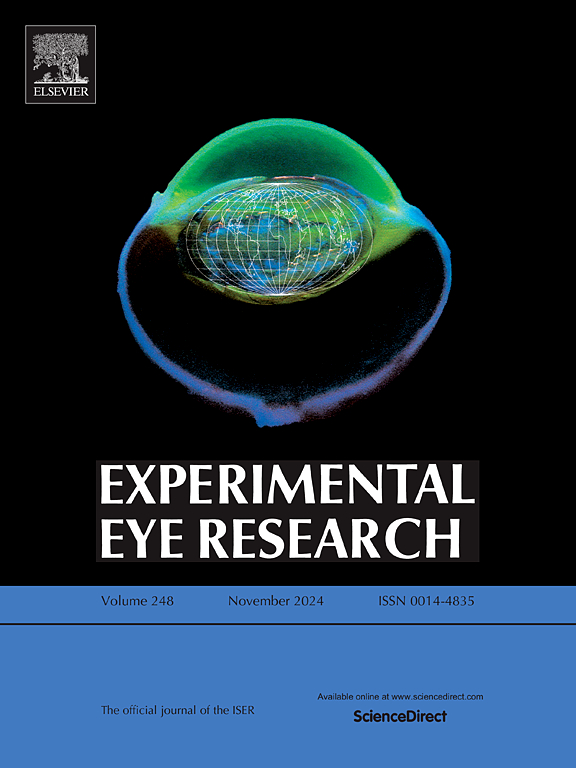应用转录组测序鉴定和探索视神经压迫大鼠模型中的生物标志物
IF 3
2区 医学
Q1 OPHTHALMOLOGY
引用次数: 0
摘要
外伤性视神经病变(TON)对受影响的个体有深远的影响,但TON的治疗仍然存在重大挑战。在此背景下,我们旨在通过转录组学方法探索大鼠视神经压迫(ONC)模型中TON的诊断生物标志物和潜在机制。我们从32个大鼠视网膜样本中提取总RNA。首先,确定候选基因和枢纽基因。随后通过随机森林(RF)和受试者工作特征(ROC)分析确定生物标志物。构建nomogram来评估生物标志物的诊断价值。最后进行功能分析、亚细胞定位分析、药物预测和基因表达验证。IFIT3、IFI44、USP18、ZBP1、IRGM和OAS1B被确定为ONC模型中的生物标志物,具有很强的诊断实用性,所有曲线下面积(auc)均超过0.8。此外,这些生物标志物被发现共同参与“细胞因子-细胞因子受体相互作用”。亚细胞定位分析显示这些生物标志物主要存在于细胞核和细胞质中。此外,还预测了8种靶向OAS1B的药物和25种靶向IRGM的药物。值得注意的是,OAS1B和IRGM对脂多糖、碳纳米管、五氯酚和银的共同靶向具有重要的治疗潜力。此外,与对照组相比,IFIT3、IFI44、USP18、ZBP1、IRGM和OAS1B的表达水平在ONC样本中显著升高,强调了它们作为ONC有前景的生物标志物的相关性。因此,我们认为IFIT3、IFI44、USP18、ZBP1、IRGM和OAS1B是ONC的生物标志物,为ONC相关研究提供了潜在的理论基础。本文章由计算机程序翻译,如有差异,请以英文原文为准。

Application of transcriptome sequencing to identify and explore biomarkers in a rat model of optic nerve crush
Traumatic optic neuropathy (TON) has a profound impact on affected individuals, yet the treatment of TON continues to present significant challenges. In this context, we aimed to explore diagnostic biomarkers and potential mechanisms underlying TON in a rat optic nerve crush (ONC) model via a transcriptomics approach. We extracted total RNA from 32 rat retina samples. First, candidate genes and hub genes were identified. The biomarkers were subsequently identified by random forest (RF) and receiver operating characteristic (ROC) analyses. A nomogram was constructed to assess the diagnostic value of the biomarkers. Finally, functional analysis, subcellular localization analysis, drug prediction, and gene expression verification were performed. IFIT3, IFI44, USP18, ZBP1, IRGM, and OAS1B were identified as biomarkers in the ONC model and exhibited strong diagnostic utility, with all areas under the curve (AUCs) exceeding 0.8. Furthermore, these biomarkers were found to be collectively involved in “cytokine–cytokine receptor interactions”. Subcellular localization analysis revealed the predominant presence of these biomarkers in the cell nucleus and cytoplasm. Moreover, 8 drugs targeting OAS1B and 25 drugs targeting IRGM were predicted. Notably, the shared targeting of lipopolysaccharides, carbon nanotubes, pentachlorophenol, and silver by both OAS1B and IRGM has significant therapeutic potential. Additionally, IFIT3, IFI44, USP18, ZBP1, IRGM, and OAS1B expression levels were markedly elevated in ONC samples compared with control samples, underscoring their relevance as promising biomarkers for ONC. Therefore, we conclude that IFIT3, IFI44, USP18, ZBP1, IRGM, and OAS1B were identified as biomarkers of ONC, providing a potential theoretical basis for ONC related studies.
求助全文
通过发布文献求助,成功后即可免费获取论文全文。
去求助
来源期刊

Experimental eye research
医学-眼科学
CiteScore
6.80
自引率
5.90%
发文量
323
审稿时长
66 days
期刊介绍:
The primary goal of Experimental Eye Research is to publish original research papers on all aspects of experimental biology of the eye and ocular tissues that seek to define the mechanisms of normal function and/or disease. Studies of ocular tissues that encompass the disciplines of cell biology, developmental biology, genetics, molecular biology, physiology, biochemistry, biophysics, immunology or microbiology are most welcomed. Manuscripts that are purely clinical or in a surgical area of ophthalmology are not appropriate for submission to Experimental Eye Research and if received will be returned without review.
 求助内容:
求助内容: 应助结果提醒方式:
应助结果提醒方式:


